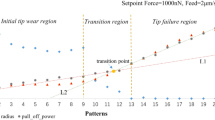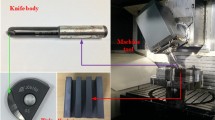Abstract
In this paper, the influences of tip wear of atomic force microscope (AFM) on evaluating the surface quality were studied. Three typical ultra-precision machined surfaces respectively machined by ultra-precision grinding, ultra-precision turning, and ultra-precision polishing were chosen, and the silicon tips with different wear degrees, the new tip, the moderately worn tip, and the badly worn tip, were employed to scan these three surfaces. By analyzing the AFM scanning results from different tips, each type of surface was characterized with the methods of 3D surface texture parameters and power spectral density (PSD). It was found that the tip wear would mainly degrade the ability of tip on measuring the valley structure and cause more artifacts when measuring the peak structure, which resulted in the effects on evaluating surface roughness parameters and identifying the high-frequency harmonic components. Moreover, due to the different topography characteristics of these three ultra-precision machined surfaces, the influences caused by tip wear on the evaluation of the surface quality were reflected in different aspects.










Similar content being viewed by others
Abbreviations
- S a :
-
Arithmetical mean deviation of the 3D surface
- S q :
-
Root mean square deviation of the 3D surface
- S z :
-
Maximum height of the 3D surface
- S p :
-
Maximum peak height of the 3D surface
- S v :
-
Maximum valley depth of the 3D surface
- S sk :
-
Skewness of the 3D surface
- S ku :
-
Kurtosis of the 3D surface
- z(i):
-
Height profile of the surface
- Z(k):
-
Fourier transform of the surface profile z(i)
- P(k):
-
One-dimensional PSD of the surface profile z(i)
- z(x,y):
-
Height matrix of the surface
- P(m,n):
-
Two-dimensional PSD of the surface matrix z(x,y)
References
Vorburger TV, Rhee H-G, Renegar TB, Song J-F, Zheng A (2007) Comparison of optical and stylus methods for measurement of surface texture. Int J Adv Manuf Technol 33:110–118
Leach R (2014) Fundamental principles of engineering nanometrology. Elsevier
Niu Z, Li J, Chen S, Pei Y, Wang X (2018) Surface quality evaluation in orthogonal turn-milling based on box-counting method for image fractal dimension estimation. Nanomanuf Metrol:1–6
Zhang S, To S, Wang S, Zhu Z (2015) A review of surface roughness generation in ultra-precision machining. Int J Mach Tools Manuf 91:76–95
Poon CY, Bhushan B (1995) Comparison of surface roughness measurements by stylus profiler, AFM and non-contact optical profiler. Wear 190:76–88
Yacoot A, Koenders L (2008) Aspects of scanning force microscope probes and their effects on dimensional measurement. J Phys D Appl Phys 41:103001
Chung K-H, Lee Y-H, Kim D-E (2005) Characteristics of fracture during the approach process and wear mechanism of a silicon AFM tip. Ultramicroscopy 102:161–171
Ebrahimi M, Zarei-Hanzaki A, Abedi H, Azimi M, Mirjavadi S (2017) Correlating the microstructure to mechanical properties and wear behavior of an accumulative back extruded Al-Mg2Si in-situ composite. Tribol Int 115:199–211
Mirjavadi SS, Alipour M, Hamouda A, Givi MB, Emamy M (2014) Investigation of the effect of Al-8B master alloy and strain-induced melt activation process on dry sliding wear behavior of an Al–Zn–Mg–Cu alloy. Mater Des 53:308–316
Alipour M, Mirjavadi S, Besharati Givi M, Razmi H, Emamy M, Rassizadehghani J (2012) Effects of Al-5TI-1B master alloy and heat treatment on the microstructure and dry sliding wear behavior of an Al-12Zn-3Mg-2.5 Cu alloy. Iran J Mater Sci Eng:9
Afshari BM, Mirjavadi SS, Dolatabad YA, Aghajani M, Givi MKB, Alipour M, Emamy M (2016) Effects of pre-deformation on microstructure and tensile properties of Al—Zn—Mg—Cu alloy produced by modified strain induced melt activation. Trans Nonferrous Metals Soc China 26:2283–2295
Mirjavadi SS, Alipour M, Emamian S, Kord S, Hamouda A, Koppad PG, Keshavamurthy R (2017) Influence of TiO2 nanoparticles incorporation to friction stir welded 5083 aluminum alloy on the microstructure, mechanical properties and wear resistance. J Alloys Compd 712:795–803
Mirjavadi SS, Alipour M, Hamouda A, Matin A, Kord S, Afshari BM, Koppad PG (2017) Effect of multi-pass friction stir processing on the microstructure, mechanical and wear properties of AA5083/ZrO2 nanocomposites. J Alloys Compd 726:1262–1273
Xue B, Yan Y, Hu Z, Zhao X (2014) Study on effects of scan parameters on the image quality and tip wear in AFM tapping mode. Scanning 36:263–269
Xu M, Fujita D, Onishi K (2009) Reconstruction of atomic force microscopy image by using nanofabricated tip characterizer toward the actual sample surface topography. Rev Sci Instrum 80:043703
Wang Y, Chen X (2007) Carbon nanotubes: a promising standard for quantitative evaluation of AFM tip apex geometry. Ultramicroscopy 107:293–298
Velegol SB, Pardi S, Li X, Velegol D, Logan BE (2003) AFM imaging artifacts due to bacterial cell height and AFM tip geometry. Langmuir 19:851–857
Sedin DL, Rowlen KL (2001) Influence of tip size on AFM roughness measurements. Appl Surf Sci 182:40–48
Zeng Q, Qin Y, Chang W, Luo X (2018) Correlating and evaluating the functionality-related properties with surface texture parameters and specific characteristics of machined components. Int J Mech Sci 149:62–72
Yu N, Chan C, Li L, Lee W (2017) Spectral analysis of surface roughness features of a lapped ultraprecision single-point diamond machined surface. Int J Adv Manuf Technol 88:1407–1415
Chen Y, Huang W (2004) Numerical simulation of the geometrical factors affecting surface roughness measurements by AFM. Meas Sci Technol 15:2005–2010
Wang C, Itoh H (2013) A simulation study for evaluating and improving the accuracy of surface roughness measured by atomic force microscopy. Meas Sci Technol 24:035401
Acknowledgments
The authors gratefully acknowledge the financial supports of the National Key Research and Development Program of China (2017YFA0701200), the National Natural Science Foundation of China (51675134 and 51705104), Key Laboratory of Micro-systems and Micro-structures Manufacturing of Ministry of Education (Harbin Institute of Technology No. 2017KM005), and the China Postdoctoral Science Foundation (No. 2017M610206 and 2018T110289).
Author information
Authors and Affiliations
Corresponding author
Additional information
Publisher’s note
Springer Nature remains neutral with regard to jurisdictional claims in published maps and institutional affiliations.
Rights and permissions
About this article
Cite this article
Xue, B., Geng, Y., Yan, Y. et al. Effects of AFM tip wear on evaluating the surface quality machined by ultra-precision machining process. Int J Adv Manuf Technol 105, 4663–4675 (2019). https://doi.org/10.1007/s00170-019-03958-x
Received:
Accepted:
Published:
Issue Date:
DOI: https://doi.org/10.1007/s00170-019-03958-x




